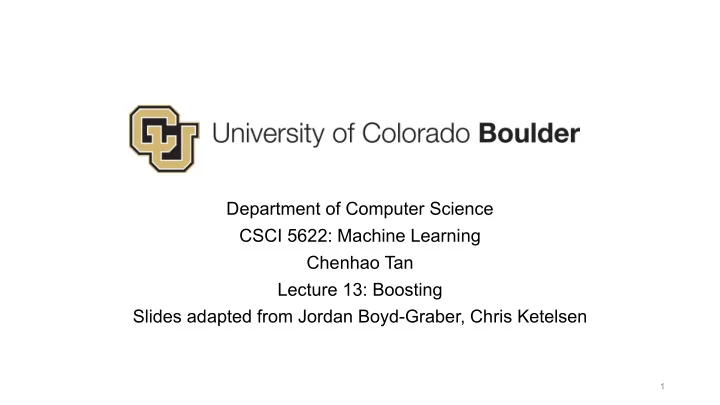

Department of Computer Science CSCI 5622: Machine Learning Chenhao Tan Lecture 13: Boosting Slides adapted from Jordan Boyd-Graber, Chris Ketelsen 1
Learning objectives • Understand the general idea behind ensembling • Learn about Adaboost • Learn the math behind boosting 2
Ensemble methods • We have learned • KNN • Naïve Bayes • Logistic regression • Neural networks • Support vector machines • Why use a single model? 3
Ensemble methods • Bagging • Train classifiers on subsets of data • Predict based on majority vote • Stacking • Take multiple classifiers’ outputs as inputs and train another classifier to make final prediction 4
Boosting intuition • Boosting is an ensemble method, but with a different twist • Idea: • Build a sequence of dumb models • Modify training data along the way to focus on difficult to classify examples • Predict based on weighted majority vote of all the models • Challenges • What do we mean by dumb? • How do we promote difficult examples? • Which models get more say in vote? 5
Boosting intuition • What do we mean by dumb? • Each model in our sequence will be a weak learner • Most common weak learner in Boosting is a decision stump - a decision tree with a single split 6
Boosting intuition • How do we promote difficult examples? • After each iteration, we'll increase the importance of training examples that we got wrong on the previous iteration and decrease the importance of examples that we got right on the previous iteration • Each example will carry around a weight w i that will play into the decision stump and the error estimation Weights are normalized so they act like a probability distribution 7
Boosting intuition • Which models get more say in vote? • The models that performed better on training data get more say in the vote 8
The Plan • Learn Adaboost • Unpack it for intuition • Come back later and show the math 9
The Plan • Learn Adaboost • Unpack it for intuition • Come back later and show the match 10
Adaboost 11
Adaboost Weights are initialized to uniform distribution. Every training example counts equally on first iteration. 12
Adaboost 13
Adaboost Mistakes on highly weighted examples hurt more Mistakes on lowly weighted examples don't register too much 14
Adaboost 15
Adaboost • If example was misclassified weight goes up • If example was classified correctly weight goes down • How big of a jump depends on accuracy of model • Do we need to compute Z k ? 16
Adaboost 17
Adaboost Example Suppose we have the following training data 18
Adaboost Example First decision stump 19
Adaboost Example First decision stump 20
Adaboost Example Second decision stump 21
Adaboost Example Second decision stump 22
Adaboost Example Third decision stump 23
Adaboost Example Third decision stump 24
Adaboost Example 25
Generalization performance Recall the standard experiment of measuring test and training error vs. model complexity Once overfitting begins, test error goes up 26
Generalization performance Boosting has remarkably uncommon effect Happens much slower with boosting 27
The Math • So far this looks like a reasonable thing that just worked out • But is there math behind it? 28
The Math • Yep! It is minimization of a loss function, like always 29
The Math 30
The Math 31
The Math 32
The Math 33
The Math 34
The Math 35
The Math 36
The Math 37
Practical Advantages of Boosting • It's fast! • Simple and easy to program • No parameters to tune (except K ) • Flexible. Can choose any weak learner • Shift in mindset. Now can look for weak classifiers instead of strong classifiers • Can be used in lots of settings 38
Caveats • Performance depends on data and weak learner • Adaboost can fail if • Weak classifier not weak enough (overfitting) • Weak classifier too weak (underfitting) 39
Recommend
More recommend